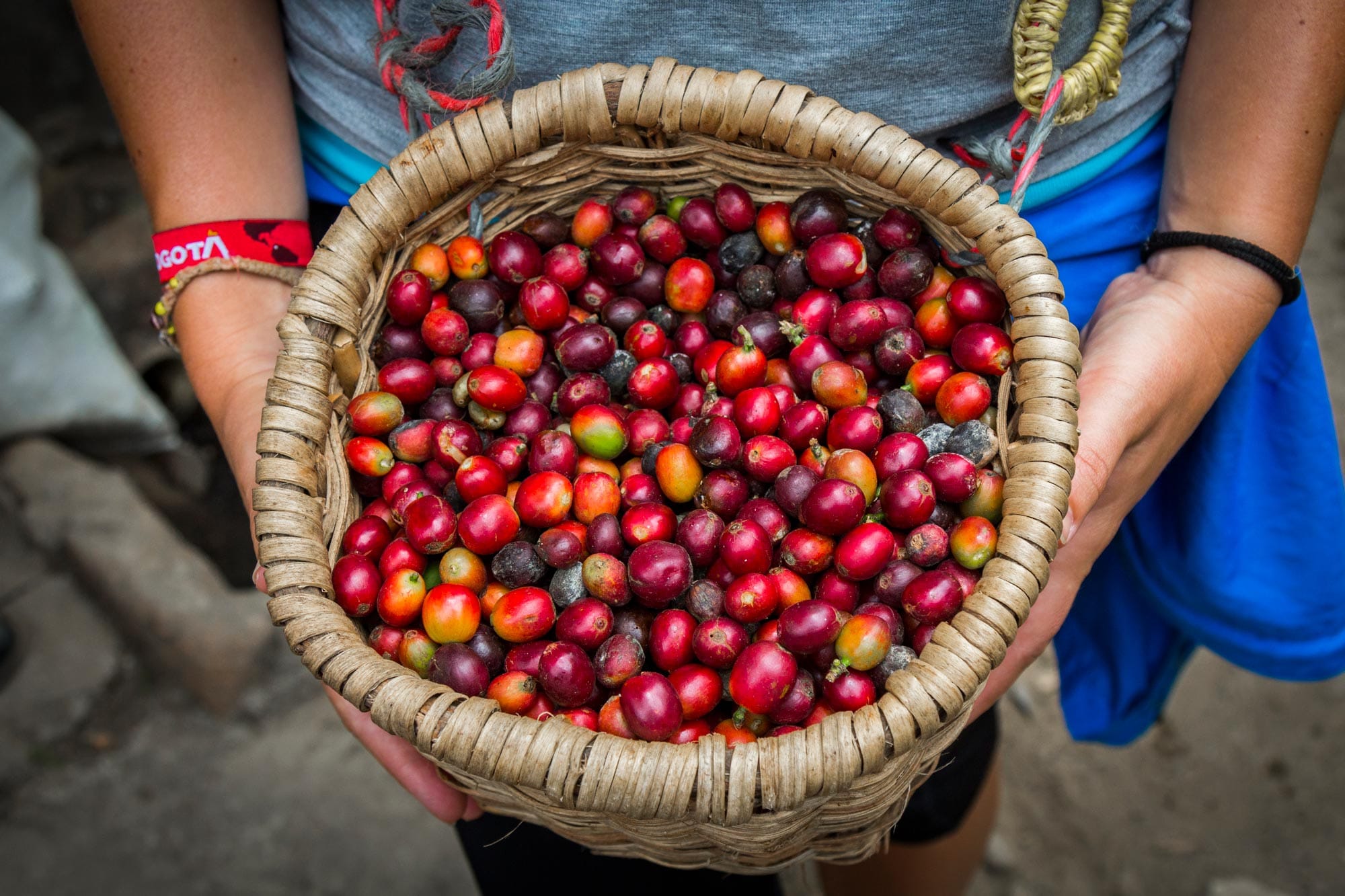By Gustavo Espinél
Colombian Coffee Zone: Insider Tips
I love to tell people about how great Colombian arts, culture, and food are because very often visitors to our country are surprised to learn about and encounter our amazing and lovely diversity in those areas. That’s why I work in both the arts and tourism. But the topic I have the most fun explaining is the one some people think they already know the most about: coffee. In fact, Colombian coffee is a very complex topic, not only regarding the cultivation, roasting, and preparation of the various drinks, but also economically, environmentally, and socially.
A great way to understand Colombia is to understand coffee, and to visit the Colombian Coffee Zone. And without a doubt the best way to do that is to visit the Colombian coffee zone. Of course, the best way to travel to the Colombia coffee zone is with Cosmopolitours because we’ll take care of every detail and make sure you’ll get the very best the area has to offer. Even if you can’t visit Colombia’s coffee lands when you travel to Colombia with us, Cosmopolitours offers exclusive coffee experiences to our travelers throughout the country.
One thing to know: there is no real Juan Valdez from the TV commercias. That is a character made-up for advertising, like the Pillsbury Doughboy, or Captain Crunch. But if there was a Juan Valdez, the way to find him would be to travel to the Colombian Coffee region.
Now, pour a cup of your favorite coffee (I live in Bogotá where the altitude is high and the weather can be chilly, so I like a strong espresso), and let me tell you where you can encounter the world’s finest coffee, as well as a plethora of experiences to kickstart your knowledge and appreciation of Colombian culture.
Travel to Manizales, Pereira, and Armenia in Colombian Coffee Zone
The Colombia Coffee Zone is also known as EJE CAFETERO, TRIÁNGULO DEL CAFÉ o VIEJO CALDAS. It encompasses the regions of Caldas, Risaralda, and Quindío in the central-western part of Colombia, nestled between the Western and Central Andes mountain ranges. It is a lush green sub-tropical region of rolling hillsides bordering the Andes.
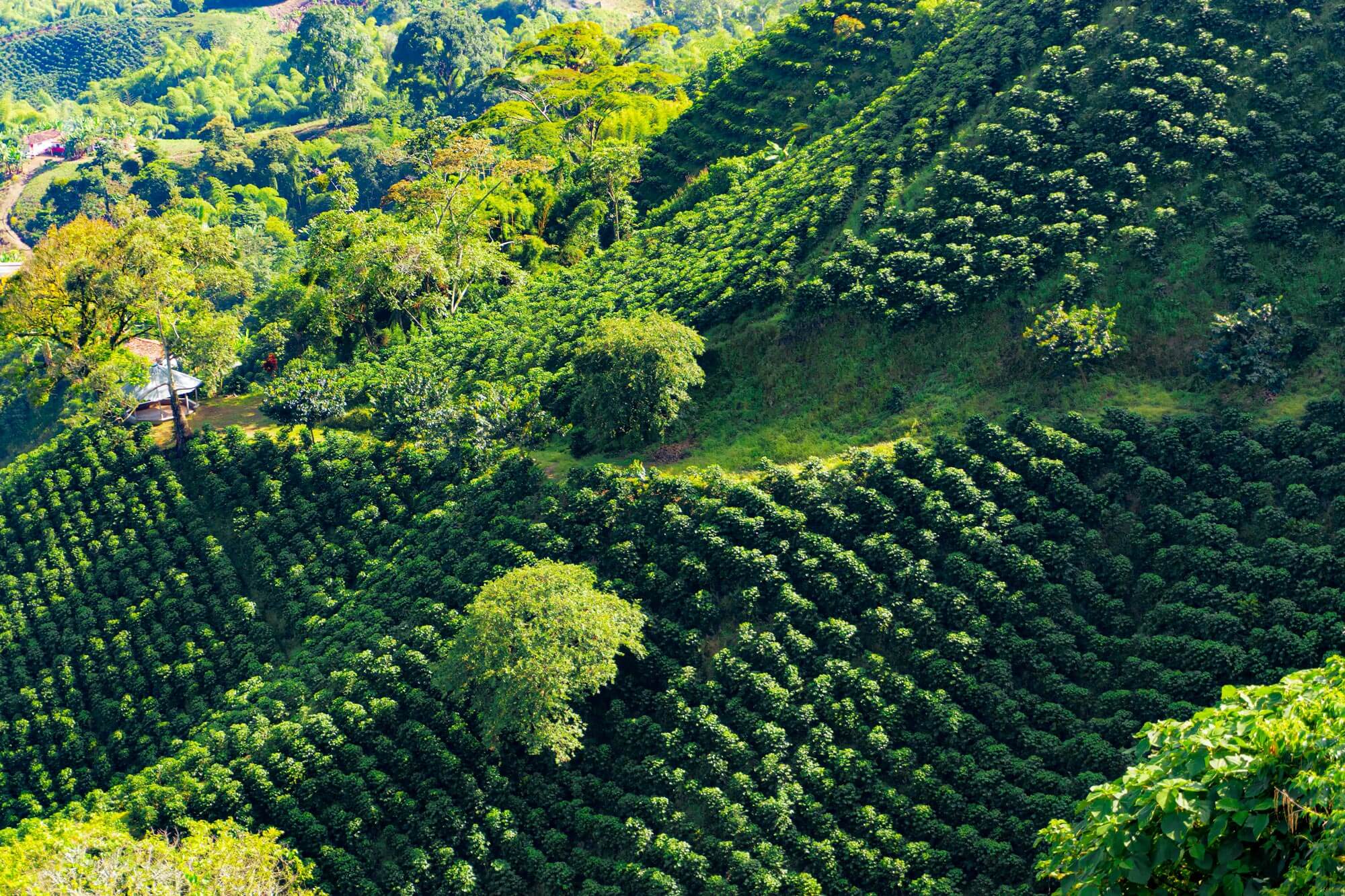
View of a Coffe Plantation in Manizalez, Colombia | Cosmopolitours
Visit the Colombian Coffee Region’s Breathtakingly Unique Landscapes
Personally, I find Colombia’s coffee zone to be a magical place. Every time I visit, either with clients or for my own interest, it revitalizes my energy and spirit through its landscapes, its people, their fabulous artisanal products, and countless fun activities.
As you descend into the international airports of any of the three nearby capital cities – Manizales, Pereira, or Armenia – it’s normal to sigh as the plane gradually immerses you in wondrous landscapes adorned with unique tropical vegetation, where some of the world’s best coffee thrives. UNESCO declared Colombia’s Coffee Cultural Landscape a World Heritage Site in 2011.
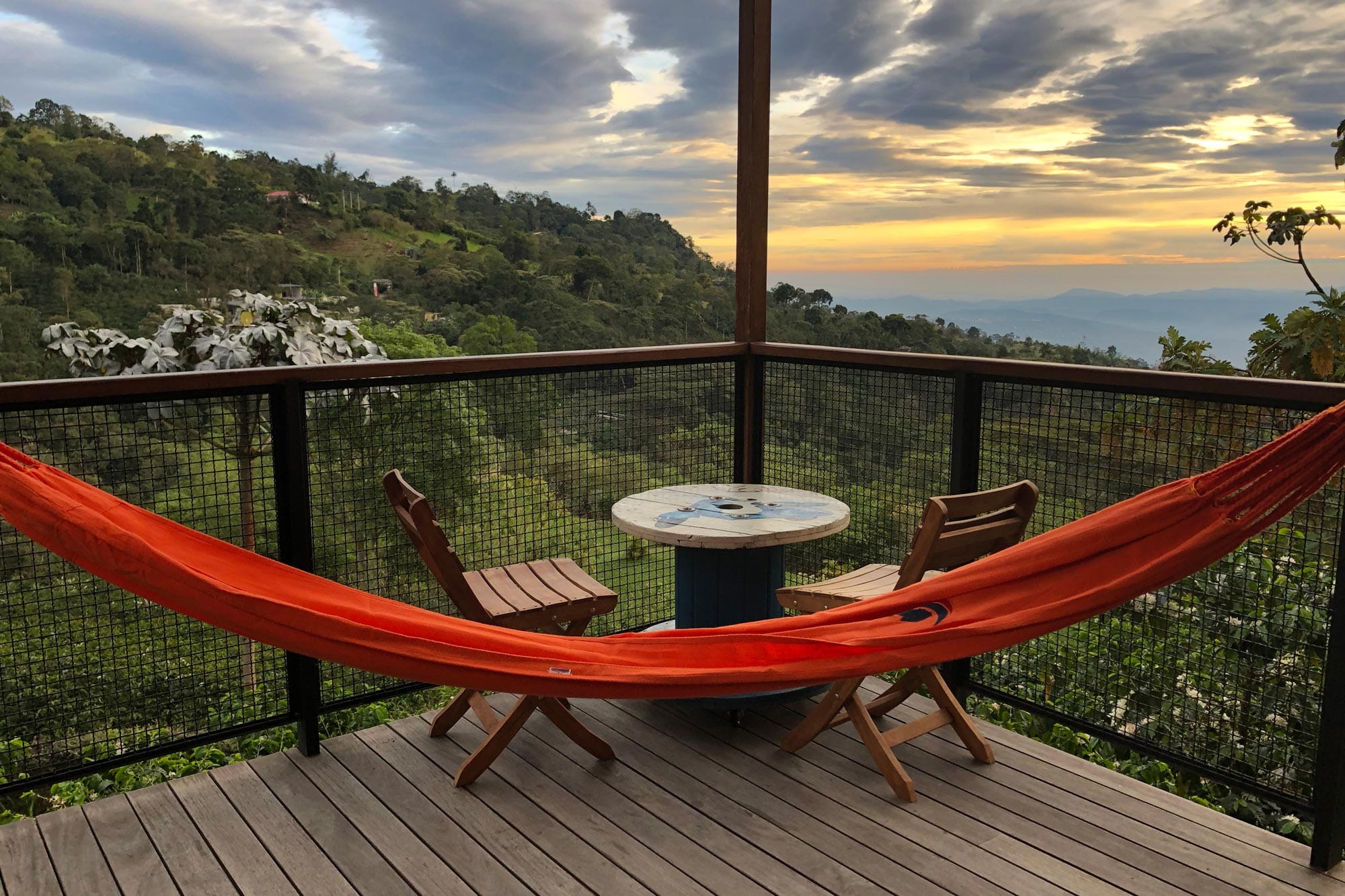
Luxury Lodgings at a Coffee Plantation in Colombia | Cosmopolitours
Where to Stay in the Colombian Coffee Zone
The lodging options in the Colombian Coffee Zone offer options for every style of travel from very well-outfitted glamping, to 300-year-old family haciendas meticulously converted into world-class boutique hotels, to sustainable eco-lodges where you wake-up to the sound of birdsong while immersed in greenery. Depending on how many nights you might visit the Colombian Coffee region, you might want to mix and match different lodgings, maybe two nights in a hacienda and a night or two glamping.
Wherever you choose to stay, you then want to traverse the beautiful towns of Salento, Filandia, Pijao, and Salamina in the area’s traditional form of transportation, the iconic Jeep Willys. You’ll discover fabulous food, centuries-old coffee farms, and captivating tropical vegetation, including wild orchids, and see colorful birds. At Cosmopolitours, we’ll guide you through a magical exploration of these areas, ensuring you understand and live this fabulous adventure!
Experience Coffee Beyond Your Morning Cup in the Colombian Coffee Region
Nestled among the mountains of the Colombian Coffee Zone are the HACIENDAS CAFETERAS, coffee farms. Some of the Coffee plantation haciendas provide travelers the highest standards of top-tier lodging, gastronomy, and service. Travel to Colombia’s Eje Cafetero is about much more than the aroma and flavor of the world’s best coffee. With Cosmopolitours we usually arrange for you to learn by participating in everything from coffee bean harvesting to artisanal production processes, through roasting, grinding, and all the different variations for coffee brewing.
It is also important to learn the economics of Colombian coffee, the role of the national syndicate of Colombian Coffee Producers, the hundred-year-old cartel that monetizes the mass production of Colombian Coffee for export to the world (these are Juan Valdez’s employers), and the recent rise of smaller scale sustainable artisanal and specialist growers since the Colombian peace process of 2016. As I said, understanding Colombian Coffee is a way to begin to understand Colombia today.
I’ve lived the complete experience on some of these Colombian Coffee Farms both the big and famous ones, and small award-winning artisanal coffee producers, and there’s nothing quite like waking up to the chorus of a thousand birds and the sounds of coffee beans being harvested and ground. You open your room’s windows to breathe pure, coffee-scented air while witnessing workers lovingly gathering and selecting the finest beans directly from the coffee plants.
Here is where you might actually encounter the real life image of Juan Valdez, embodied by a farmer “arriero” dressed in a “carriel,” aguadeño hat, and poncho, transporting the coffee on a Jeep Willys.
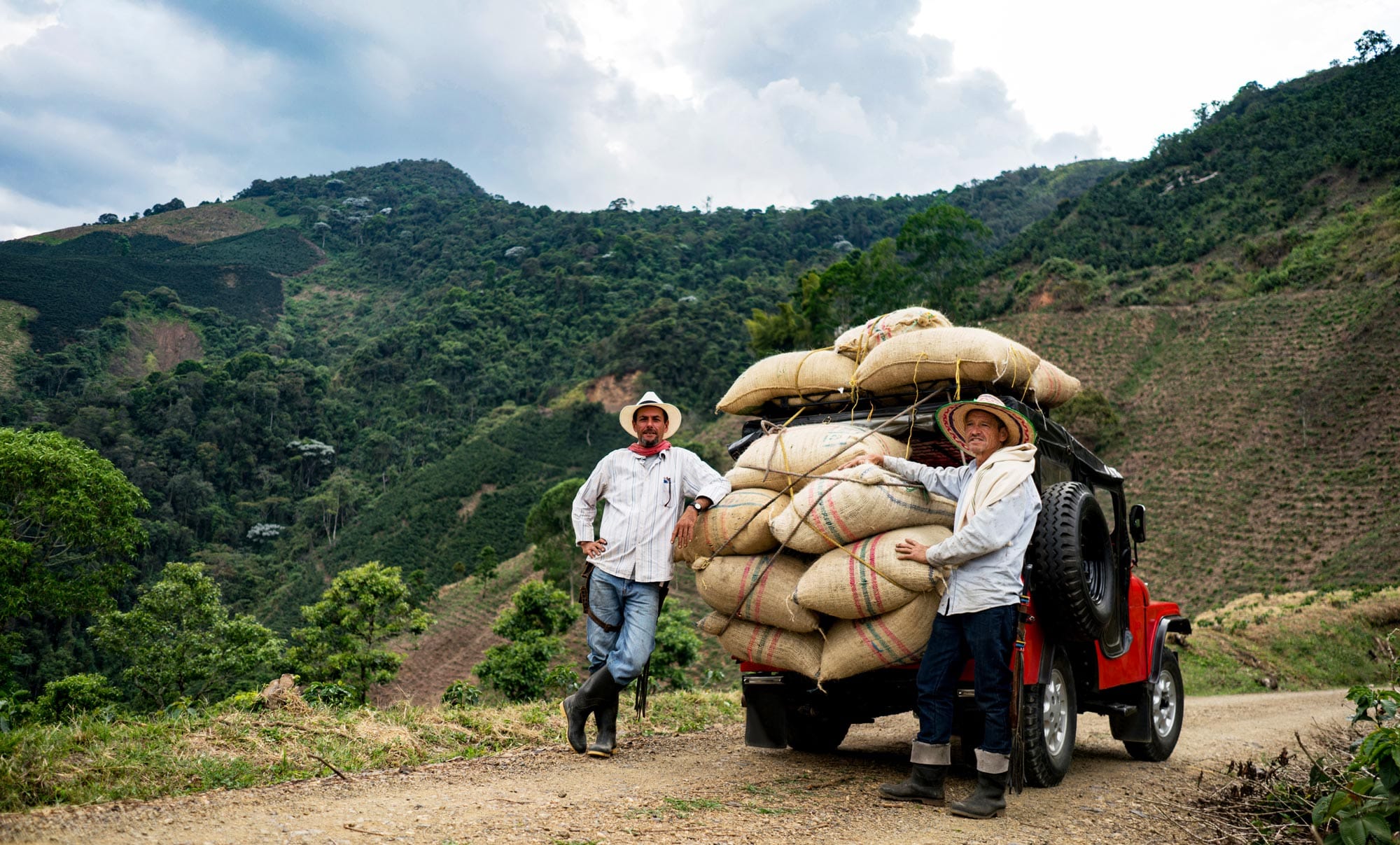
Colombian Coffee Farmers “Juan Valdez” | Cosmopolitours
Experience the Colors of the Colombian Coffee Region’s Traditional Towns
You’ll be amazed by the traditional architecture of Pijao, Salento, and Filandia, where myriad colors create a magical ensemble with the landscapes. In fact, this was the inspiration behind the Disney movie Encanto. On the weekends, the town squares or plazas, come alive with people buying fruits and vegetables, and families out for a stroll with their kids. One of the most charming things to see is little kids enjoying pony rides, or rides around the plazas in mini jeeps!
You can also journey to the Santa Rosa de Cabal hot springs, a natural wonder where you can relax with a spa session amid some of Colombia’s most beautiful mountains.
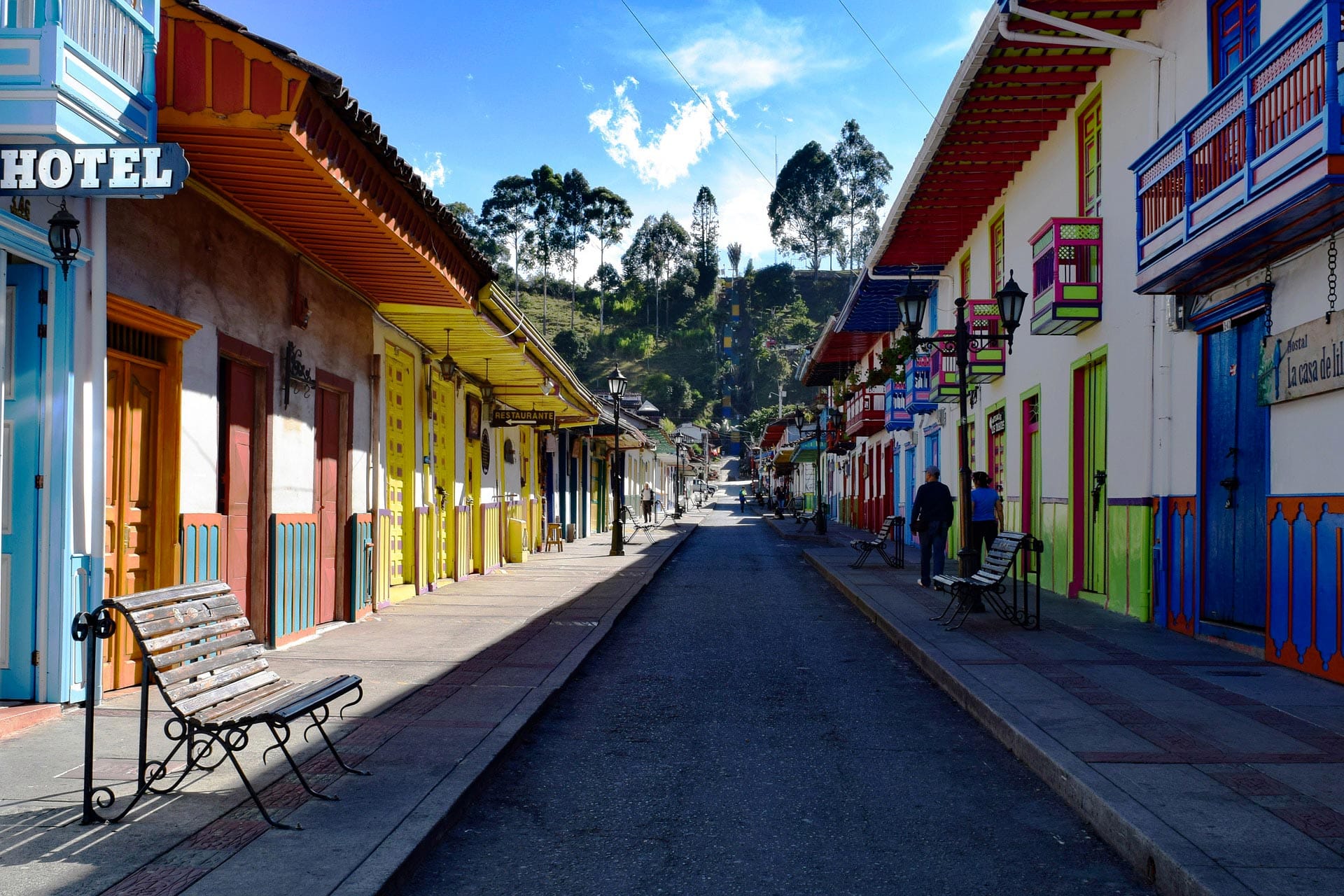
Town of Salento on the Coffe Region, Colombia | Cosmopolitours
Best Shopping in the Colombian Coffee Zone
As I have mentioned, the artisanal goods are superb. You can get up close with the work of local artisans who have crafted high-quality, design-focused products, which have become very hot export items. It’s very fun walking through the shops near the central plazas of Filandia and Salento where you can discover beautiful unique contemporary jewelry and decorative goods, and also long-established family shops which have been offering traditional goods for generations. Of course, you need to be patient and really explore to weed-out the tourist traps selling second-rate goods to find the really good buys.
A couple of pro-tips to find the best shopping in the Colombian Coffee Region:
- Usually any shop selling curio items, like plastic mass-produced key chains or corny T-shirts with Marilyn Monroe or even Frida Khalo poster “art” should be avoided.
- Look for shops that show “proof” of the original production of whatever they are selling. Sometimes they may have a small workshop demonstration area on-site, but more often they proudly display photos of their goods being produced in workshops located in the surrounding hills where they have ready access to prime materials, and plenty of space to work.
- Don’t always assume that the younger artisans are inferior to the old-timers. In fact, there are several younger producers who studied abroad at some of the world’s best art schools who have returned to Colombia since the peace process to re-claim traditional products by presenting them with contemporary designs.
Personally, I recommend purchasing handwoven baskets from the workshops in the small towns. You’ll have fun walking around exploring, and you can find incredible pieces from architectural scale to smaller decorative items. They are creations crafted from the fibers of the giant tropical Bamboo we call “guadua biche” using ancestral and traditional techniques, representing craftsmanship tracing back to the indigenous groups that once inhabited the area.
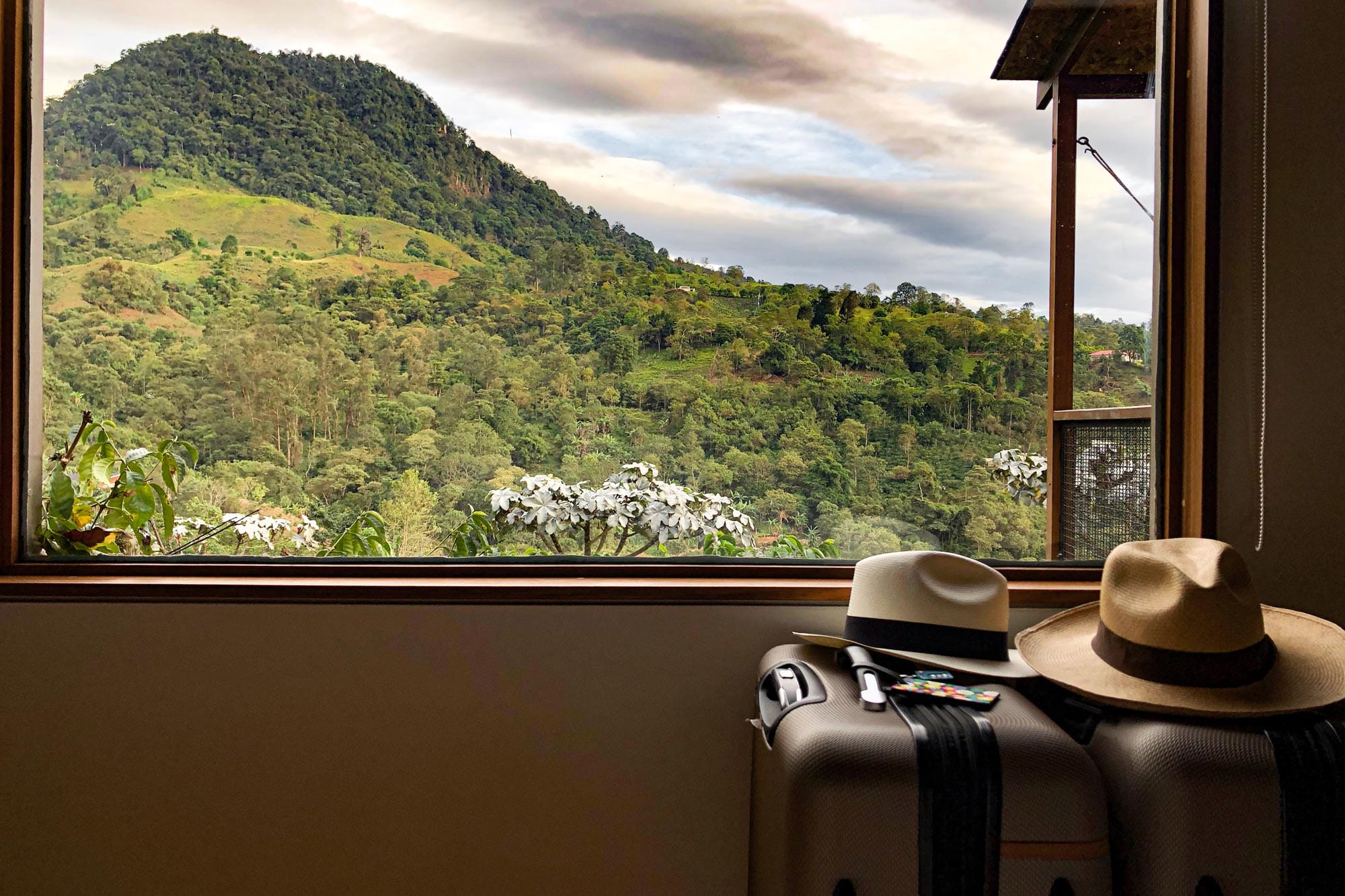
Colombian Aguadeño Hat by Andres Hurtando, Manizales | Cosmopolitours
I also recommend everyone, men, women, everyone, to purchase a handcrafted aguadeño hat (our far-superior version of the Panama Hat) from a master hatmaker like Andres Hurtando in Manizales. Unlike the disposable cheaply made hats available practically on every street corner of every tourism area in Colombia, a real finely produced aguadeño will handle sun and sweat and last for years – and make you look good!
The Colombian Coffee Zone Is Also a Culinary Destination
The Eje Cafetero isn’t just about coffee. Thanks to its tropical climate and continuous production of fruits and vegetables, its cuisine has been enriched with various traditions and flavors. Colombian coffee region foodie travel experiences allows one to sample tropical fruits of the area, locally produced chocolates, fruit and herb infusions, and in the last ten years locally cultivated teas that have gradually intertwined with the coffee production. There is a vast array of restaurants and places where you can savor everything from traditional dishes to contemporary creations guided by experimental chefs.
I personally love having lunch in Salento, where they serve what many say is the finest trout in South America. These wild-caught trout thrive naturally in the cold rivers and streams flowing down from the Andes mountains, including the Ruiz and Tolima snow-capped peaks, crossing through the Cocora Valley.
My favorite restaurant in Salento is Restaurante Donde Laurita Campestre, in a lovely traditional home with a central courtyard. They make unique preparations of these trout combine local ingredients into sauces, sometimes enchilado red sauces, cremoso cream sauces, and sometimes grilled and sprinkled with local herbs. Of course, this feast of traditional food must conclude with a delicious dessert made from regional fruits, paired with a “tinto,” as Colombian coffee is lovingly called.
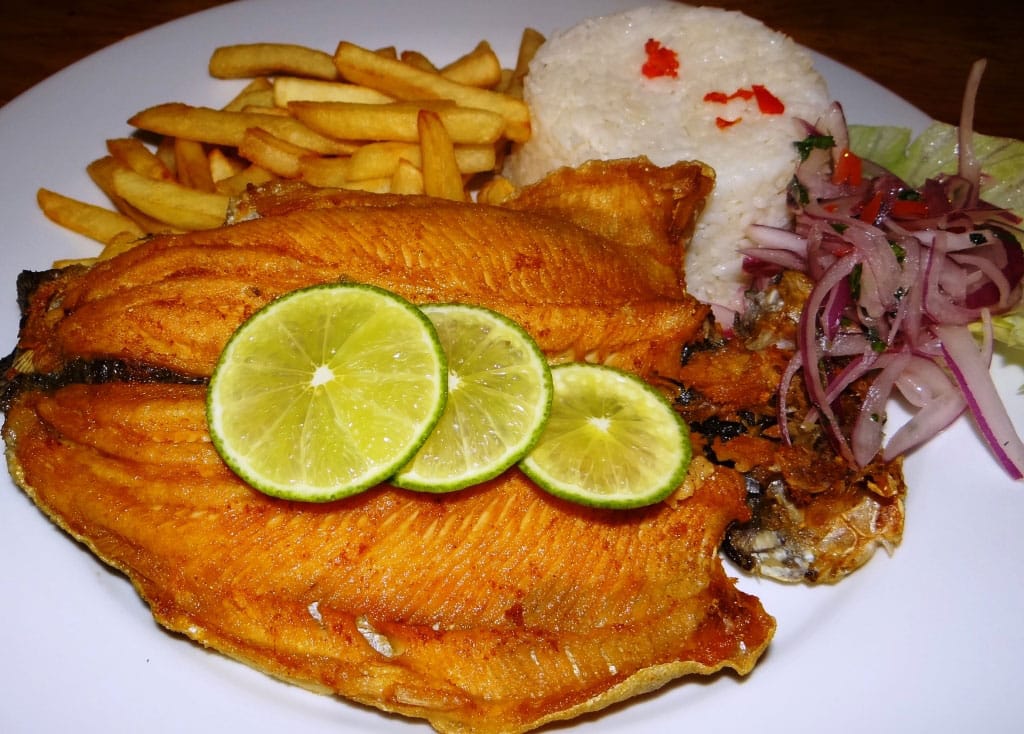
Colombian Fried Trout | Cosmopolitours
I also highly recommend the chorizos from Santa Rosa de Cabal. These savory sausages undergo a special process, being infused with a variety of local herbs and slow-cooked to irresistible perfection!
As you can see, travel to the Colombian coffee region offers a multitude of experiences that you can come to know and enjoy in exquisite detail. Best still, Contact Us for a customized trip to the Colombian coffee zone that we’ll tailor to your interests and preferences. I eagerly await you so that together, we can explore this enchanting region, enveloped in the rich aroma and flavor of Colombian coffee.

Gustavo is an arts and antiquities authenticator, a curator, a self-proclaimed evangelist for the “new Colombia” resulting from the peace process, and one of Cosmopolitours clients’ most favored guides. As a former professional dancer, he is known to bust a move any chance he gets.

